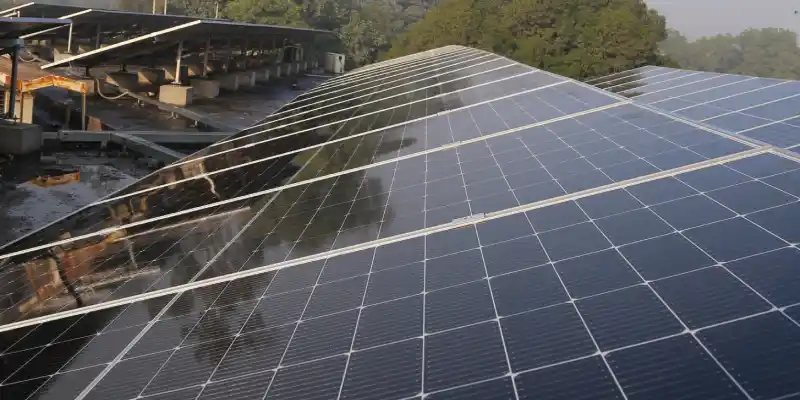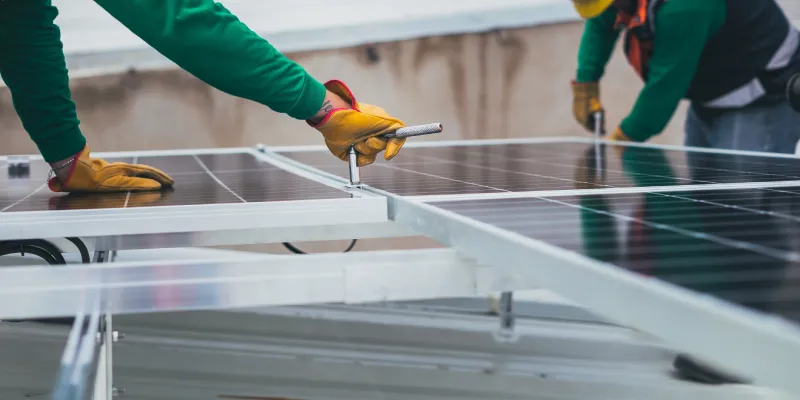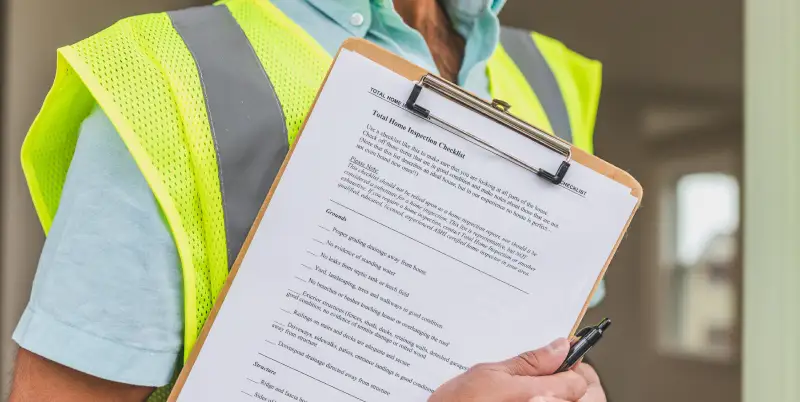How much do solar panels cost for businesses?
Installing a solar panel system on a commercial property is becoming increasingly attractive as the technology becomes more established in the UK.
Not only has the number of installers grown rapidly, but solar systems have also improved dramatically over the last decade.
Here’s everything you need to know about the cost of solar panels for businesses.
Contents
- Overview of business solar panel costs
- What are the key cost factors that influence the cost of solar panels to your business?
- Core Hardware costs
- Optional Component Costs
- Labour costs involved with installing solar panels
- What permits and inspections will be required for my business?
- Additional costs and considerations
Overview of business solar panel costs
In the UK, the cost of solar panels for businesses largely depends on the system’s size and complexity.
As of 2024, the average price for commercial solar installations ranged between £1,000 to £1,500 per kWp (kilowatt peak). For a medium-sized business that requires a 30kWp system, this translates to an estimated cost of £30,000 to £45,000.
Several factors can influence this price range:
- Type of Panels: Products like solar roof tiles will be costlier than traditional panels but will satisfy niche customers.
- Installation Complexity: Businesses with non-standard roof structures or those requiring ground-mounted panels may face higher costs.
- Additional Equipment: PV solar battery storage systems, advanced monitoring setups and EV charging (amongst others!) can add to the initial investment.
While the upfront costs can seem substantial, it’s crucial to consider the long-term energy savings, potential government incentives, and the benefits of being a carbon neutral (or low carbon) business.
In fact, your business may eventually find a new revenue stream through electricity arbitrage using the Smart Export Guarantee scheme.
💡 The price of solar panels has steadily decreased over the last decades and is currently its historical lowest, making solar more accessible to all businesses.
Importance of understanding solar panel costs
Fully grasping the costs of solar panels is vital, just like any business infrastructure investment.
The costs and benefits will vary depending on your business needs and how well you can utilise what is currently available. Understanding and optimising for all key cost factors explained in this article will let you see all the cards before you play your hand.
This way, your business will know perfectly what it’s getting into, why, and how to budget for it accurately.
💡 The ambition of your company can range from simply reducing business electricity rates, to obtaining complete independence from your business energy supplier, eliminating the need for business energy bills. The costs and benefits of each are worlds apart!
What are the key cost factors that influence the cost of solar panels to your business?

The wide range of installation possibilities means that the cost for the entire system can vary greatly, from a straightforward cost-cutting system to an intricate, entirely off-grid system.
The table below summarises the cost breakdown of the key cost factors of a typical system installed on a business property comprising monocrystalline roof-mounted PV solar panels, batteries and a hybrid inverter, all self-funded:
| Description | % of total (typical installation) | |
|---|---|---|
| Solar Panels | Power generation unit(s) | 20% |
| Inverter(s) | AC/DC Inverters | 15% |
| Batteries | Energy storage unit(s) | 20% |
| Mounting systems | Support and inclination structure | 10% |
| Monitoring System | Smart meters, monitors, and energy management system (incl. programming). | 5% |
| Labour | Assessment, permitting, installation, commissioning, maintainance | 30% |
| Extras | Backup Generators, EV charging stations, heat pumps, etc. | Add-On |
The relative costs may vary greatly when considering alternative technologies and approaches. For instance, installing solar roof tiles or ground-mounted panels may significantly increase the labour cost proportional to hardware. Click on the factor on the table for a more detailed breakdown of costs.
Note that most suppliers will only offer typical installation–niche solar projects for businesses with alternative solar ambitions may need specialised technicians.
Core Hardware costs
The following are the core components of any solar panel system:
These components will always be present on every installation (battery systems are rapidly becoming core, but we cover it separately here).
Their relative costs will vary significantly depending on the system, but typically, the panels are the most expensive, and the mounting system is the cheapest part.
Solar PV panel costs
The cost of this core equipment will come from the photovoltaic panels themselves, with the price based on capacity, efficiency, and the technology chosen.
The table below is a comprehensive list of all solar technologies and their approximate cost per lifetime kWh:
| Status | Cost / Lifetime kWh (£ - ££££) | |
|---|---|---|
| Monocrystalline PV | Most common | £ |
| Polycrystalline PV | Cheapest initial cost | ££ |
| Solar water heaters | Solar heating, not electricity | £ |
| Solar Thin Film | Still a niche product | ££ |
| Solar PV Roof tiles | Niche, but growing fast | £££ |
| Integrated Solar PV | Niche, but growing fast | £££ |
| PERC PV | Still a niche product | £ |
| Solar Glass | Still a niche product | ££££ |
| CPV | Not avilable yet! | n/a |
| Tandem Si-Perovskite | Available Soon! | n/a |
Note that what is cheaper for your business ultimately depends on your infrastructure, your specific goals and the local availability of niche products.
Inverter costs
Inverters are a crucial component of any solar PV system, converting the direct current (DC) produced by solar panels into alternating current (AC) your business utilises.
Some solar system designs will have a single String Inverter doing the DC/AC conversion for all the panels. Still, others will have Microinverters installed at each individual panel to optimise and convert energy separately (this is especially useful if panels receive uneven sunlight due to shading).
Solar batteries also charge and discharge using DC current, so they will also require two-way Battery Inverters to connect to the rest of your business’ circuit, especially when installed separately from the panels.
Conversely, integrated battery and panel installations usually have a direct DC connection between these two components to avoid a double DC/AC conversion. Only a single two-way Hybrid Inverter is necessary between the integrated battery + panel system and your main electricity circuit.
Note that contemporary two-way solar inverters (i.e. battery and hybrid inverters) come with an in-built controller that is in charge of directing the flow of electricity from each component of the system. A sophisticated controller provides unprecedented customisability but comes at a higher price.
The table below gives a generalised comparison of the relative cost of these inverter types:
| Description | Relative CAPEX (£ - £££) | |
|---|---|---|
| String Inverters (1-way) | Panels (DC) -> Mains (AC) | £ |
| Microinverters (1-way) | Each Panel (DC) -> Mains (AC) | £££ |
| Battery Inverters (2-way) | Battery (DC) <-> Mains (AC) | ££ |
| Hybrid Inverters (2-way) | Panels + Battery (DC) <-> Mains (AC) | £££ |
💡 The power capacity of the inverter has to match the peak power generation of the solar panels and/or the peak discharge power capacity of the battery.
Mounting Systems & Wiring Costs

Mounting systems are the last crucial part of the core solar panel components. They are the foundational structure of the generators, which can be as simple as an aluminium frame that can be attached to roofs to sophisticated sun-tracking mounts that optimise the orientation of the panels. There are three types:
| Description | Relative cost (£ - £££) | |
|---|---|---|
| Roof-mounted | Most common. Attached directly to rooftops | £ |
| Ground-mounted | Installed on the ground; useful for larger systems or unsuitable roofs. | ££ |
| Tracking system | Pivot panels to follow the sun, maximising energy capture. | £££ |
Regarding wiring, the panels, inverters, batteries, connectors and junction boxes must be safely connected using sturdy wires that can resist fire, impact, grease, oil, UV light and water. Wiring costs are typically a tiny cost compared to mounting systems, inverters and panels.
Both the mounting system and wiring will typically have 20-25 years of warranty.
💡 Businesses with water bodies on their property can potentially utilise them for solar power generation by using floating mounting systems that come with the benefit of being more efficient while keeping the water cooler for wildlife.
Optional Component Costs
The following are typical optional components of any solar panel system:
- Solar PV batteries
- Monitoring System
- Other (EV charging, Heat pumps, Generators)
Solar PV Battery Costs
Many consider solar batteries a core component as they dramatically boost a simple intermittent system into a 24/7 complete power solution.
In any case, batteries add a significant cost to a system, comparable to inverters and panels. Typically, an integrated solar panel + battery system will have matching power generation and storage capacity.
So if 10kW of solar panels are installed on your property, you’ll likely be recommended a 10kW battery with 10kWh of energy storage capacity- which tends to cover self-consumption as a rule of thumb. For more information, check out our article on what size commercial solar battery you need.
The costs of your solar PV battery system will also be highly variable, depending on the technology you choose. The table below summarises existing battery technologies and their relative capital cost:
| Description | Relative CAPEX (£ - £££) | |
|---|---|---|
| LiFePo Li-Ion | Safest, most durable battery. | £££ |
| NMC Li-Ion | Most established and highest energy density | ££ |
| Lead Acid | Cheapest upfront cost. Most rudimentary tech. Great for outdoors. | £ |
| Flow batteries | Not commercially available yet! | n/a |
Again, the most cost-effective battery ultimately depends on your specific requirements, but typically Li-Ion batteries are, at present, the preferred option given their durability and customisability.
💡 Other forms of small-scale energy storage are emerging in solid-state and flow batteries, which remove the need for troublesome Lithium from the equation.
Monitoring System Costs
As the main user interface of your solar system, business energy monitoring systems are considered by many to be essential. The only reason we consider it optional is because the most straightforward solar system can operate without it.
While contemporary monitoring systems collect, process and display data wirelessly from panels, inverters, batteries and even smart gadgets, older systems require stand-alone sensors as add-ons.
The UI display is typically provided in a smartphone/tablet app and, in some cases, in a stand-alone energy display monitor device.
Typical metrics include Power generation, efficiency, Ratio of generation to imports, power injection, CO2 savings, etc.
We digress; the initial costs associated with monitoring are:
- Monitoring Software: UI, reporting, analytics and cloud storage. Some free options are available, but others will require a subscription.
- Monitoring Hardware: In older or sophisticated systems, extra sensors are installed to acquire the necessary data.
💡 Lead-Acid batteries are rudimentary and incompatible with monitoring systems because it is difficult to estimate their state of charge accurately.
Extra Component Costs
In addition to mainstream solar panels, installations may also include additional components to cater for niche use cases.
For instance, EV owners may want to integrate EV charging into their solar panels system to optimise their EV costs or install heat pumps and solar water heating to overhaul their expensive gas boiler heating system.
Here are the estimated costs of some of these extra components:
- EV charging unit: Can cost up to £1,000, although you may be eligible for government grants.
- Air-source heat pumps: Between £7,000 and £14,000 depending on building size.
💡 Businesses who wish to go entirely off-grid will also require a power generator for emergencies. They could still monetise excess electricity generation through agrivoltaic solar farms.
Labour costs involved with installing solar panels
Labour is typically the most expensive part of getting a solar system, with most of the expense being incurred during the actual installation process. For a typical setup:
| Description | Typical cost distribution | |
|---|---|---|
| Site Assessment | Professionals inspect the site, determine solar potential, and suggest the best system type. | 5% |
| System Design | Designing the layout of the panels for optimal orientation and tilt. | 5% |
| Permitting | Obtaining necessary permits and handling paperwork. | 5% |
| Installation | Panel mounting, inverter/battery installation, system wiring, controller and monitoring configuration. | 75% |
| Inspection & Commissioning | Professionals inspect the completed installation for safety and performance standards. | 5% |
| Maintenance | Initial maintenance or service checks if offered in packages. | 5% |
While a typical commercial installation will typically require a handful of staff and take a few days, more complicated setups can take significantly longer, incurring a much higher total labour cost.
The labour involved in the installation
A typical installation may only require an experienced engineer and a small team of MCS-qualified technicians and installers who are familiar with local regulations and have a close working relationship with the local council.
Comparatively, a sophisticated purpose-built installation requires a much larger team that includes specialist consultants like a QAQC and design engineers, a project manager, etc.
Factors affecting labour costs
Like in any project of any kind:
Labour Costs = Hourly Rate * Number of Labourers * Number of hours
In other words, typical implementations are significantly cheaper because there is no need for expensive specialists and consultants, and commissioning can happen in a few working days.
💡 Remember that you’re not likely to be given a budget or bill with the breakdown of all costs (like in this article). Installers typically give you a total that is inclusive of the labour costs, hardware, etc.
What permits and inspections will be required for my business?

Any business in the UK considering a solar panel installation needs to be aware that several permits and inspections are needed; the exact requirements depend on your local council and the size and location of the installation, among others.
Here’s a general overview:
Planning Permission
Most standard installations on commercial buildings will not require planning permission since solar installations on commercial properties often fall under ‘Permitted Development Rights’.
However, if:
- The building is listed or located in a conservation area, a World Heritage Site, or an Area of Outstanding Natural Beauty, or;
- The panels protrude significantly or are installed on a wall facing a road
You likely need to apply for planning permission from the local council.
Building Regulations
Building regulation approval may be needed, especially concerning the structural integrity of the roof and electrical safety. This is covered by Part P of the Building Regulations that cover electrical safety in dwellings, ensuring that electrical work, including solar PV installations, is carried out safely.
DNO Approval
For larger installations or systems that will feed significant excess electricity back into the grid, your business will likely need approval from the local Distribution Network Operator (DNO), who ensures the grid can handle the extra electricity without disruptions.
MCS Certification
While not a permit per se, ensuring that your installation is done by an MCS-certified installer using MCS-certified products will qualify you for government incentives or specific tariffs like the Smart Export Guarantee.
If this is not the case, an MSC-certified inspector (who can be part of the installation company) can ensure the installation complies with all safety standards and performs as expected.
Other Inspections
Each local council has specific local regulations that may apply to your solar panel system, like periodic safety and performance inspections.
💡 Working with local solar panel installers is preferable because they tend to have an existing relationship with the local council and understand local regulations. This may differ between a problem-free installation and one with delays and unexpected costs.
Additional costs and considerations
Besides the overall costs of the installation, which we cover above, there are other labour expenses associated with the installation of solar panels on business properties:
Maintenance and repairs
Regular check-ups and basic maintenance may be provided as part of the installation package, although this is not always true. This includes periodic panel checks to ensure they’re free from dirt, debris, or shading that could decrease efficiency.
This is an area where the monitoring capabilities of solar panel systems become important as they can help businesses self-identify any faults with the system, as it typically translates to a loss in overall performance.
💡 One key advantage of any solar energy system over wind, hydro and AWEs is the lack of moving parts that suffer from mechanical wear and tear, reducing maintenance and repair costs.
Warranty
All main components and workmanship will be typically covered by a warranty that is determined by manufacturer/installer, product type, and region.
Manufacturer Warranties:
- Panels: Monocrystalline solar panel manufacturers offer a 20-30 year warranty for performance, guaranteeing the panels will produce a certain percentage of their rated output after a set number of years.
- Batteries: Typical Lithium-Ion batteries will come with a 10-year warranty for performance, guaranteeing the batteries will retain a specific capacity after a set number of years.
- Inverters: Usually come with a warranty ranging from 5 to 15 years.
Installer Warranty:
This usually covers the workmanship or corrosion of the mounting system and might last for a shorter duration, often 5-10 years.
Insurance
While a warranty protects you from faulty components and poor workmanship, insurance covers the unexpected at an extra cost.
Solar panel insurance can be incorporated into business property insurance or as a stand-alone product, typically covering damage due to natural and man-made disasters, vandalism, etc.
Speak to your insurance broker for more information.
Financing
There are many financing options for business solar panel installations in the UK. These include:
- Self-Financing
- Loans
- Leases
- Corporate PPA
- Community Funding
- Business energy grants
We cover all things solar panel financing in our in-depth guide that we will publish soon!
Save on business utility bills
Using AquaSwitch comparison services, you can save thousands on your utility bills by simply switching to a more convenient deal:

